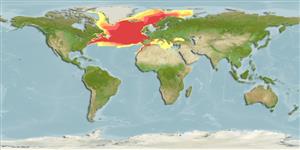Preferred temperature (Ref.
123201): 3.1 - 13.9, mean 7 °C (based on 157 cells).
Índice de diversidade filogenética (Ref.
82804): PD
50 = 0.7500 [Uniqueness, from 0.5 = low to 2.0 = high].
Bayesian length-weight: a=0.00417 (0.00343 - 0.00507), b=3.12 (3.06 - 3.18), in cm total length, based on LWR estimates for this species (Ref.
93245).
Nível Trófico (Ref.
69278): 4.1 ±0.3 se; based on diet studies.
Generation time: 4.8 (3.1 - 5.0) years. Estimated as median ln(3)/K based on 15
growth studies.
Resiliência (Ref.
120179): médio(a), tempo mínimo de duplicação da população 1,4 - 4,4 anos (K=0.18-0.22; tm=1-5; tmax=20; Fec=6000).
Prior r = 0.47, 95% CL = 0.31 - 0.70, Based on 9 full stock assessments.
Fishing Vulnerability (Ref.
59153): Low to moderate vulnerability (32 of 100).
🛈
Climate Vulnerability (Ref.
125649): Low vulnerability (18 of 100).
🛈
Nutrients (Ref.
124155): Calcium = 59.8 [18.9, 176.3] mg/100g; Iron = 0.423 [0.151, 1.166] mg/100g; Protein = 17.6 [15.2, 20.1] %; Omega3 = 0.249 [0.113, 0.554] g/100g; Selenium = 8.99 [2.88, 24.62] μg/100g; VitaminA = 33.2 [3.4, 311.2] μg/100g; Zinc = 0.712 [0.380, 1.580] mg/100g (wet weight); based on
nutrient studies. 